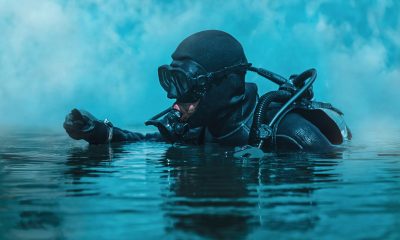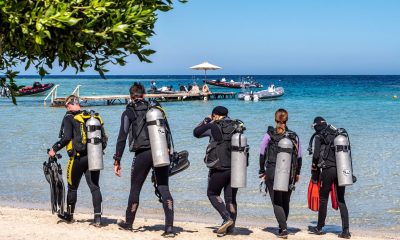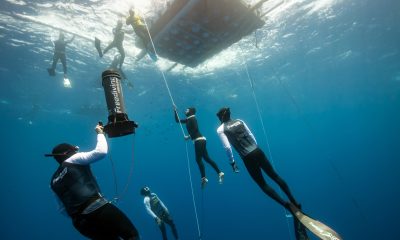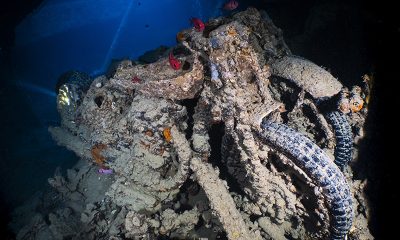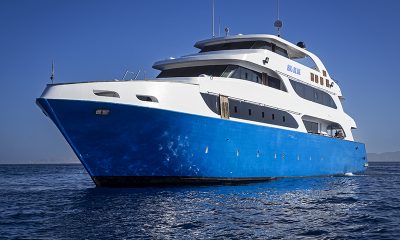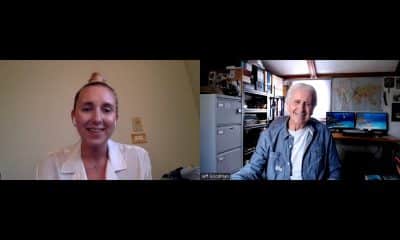Travel Stories
JOURNEY TO THE LIGHTHOUSE REEF
My name is Carole, I have been diving for 18 years and I’ve been a PADI Instructor for 17 of them. Today I am the Technical Manager at Fantasea Divers, responsible for overseeing the dive operation and working with Chris Harding, who together with Ema Louis is a partner at Coral Hotel & Fantasea Dive Center, located 90km North of Sharm el Sheikh.
Like me, when asked what inspired them to start diving, many divers of my generation relate their thirst for the underwater realm to that of the legendary Jacques Cousteau, who in his time was a trailblazer and conservationist for the underwater world and its inhabitants.
When the time was right and an opportunity arose to realize one of my dreams, I learnt to dive. Little did I know, way back then, it was just the start of the journey I was to undertake after completing the PADI Open Water Course with James & Mac at Barracuda Dive Centre in Hurghada.
That said I was absolutely not prepared for the tedious & boring hours of theory we had to sit through in the classroom. I really wondered what the hell I was doing when out of the window all I could see were other tourists around the pool enjoying themselves knocking back the Stella……… but when the time came & we were jumping off a boat into the clear blue waters of the Red Sea I was instantly hooked – I loved it and could definitely see myself living this life.
In fact on my return home I joined a dive club called Dive Force Marine and started working my way through the PADI courses up to Instructor. I experienced the delights of the popular UK training sites such as Stoney Cove, Swanage & Gildenburgh to name but a few. Every opportunity I got was spent under water. Within the year I was on my way to Malta with a bunch of other wannabe Instructors under the tutelage of PADI Course Director Gary Mawson and his entourage of IDC Staff.
Soon after I successfully passed the IDC IE, the company I was working for was relocating and I was given two options – I could continue with the rat race, or alternatively accept voluntary redundancy and a wad of cash; a no-brainer really! My dream was coming true and without hesitation I took the wad, tied up loose ends and flew back to Egypt, a place that has felt like home like no other.
I arrived in Dahab in March 1994 quite by chance. I originally went back to Hurghada to look for work, but it was their winter season and most places were fully staffed and wanted German speaking Instructors. Having spent a couple of years in Germany with the army I only knew the most important phrases that mattered to me, ‘zwei bier bitte’, ‘ein kaffee bitte’ & my all time favorite used at Macdonalds in Paderborn, ‘keine zwiebel bitte’ – none of which was really going to get me far!
One evening, after consuming a large amount of the local brew in Peanuts bar in Hurghada, a plan was hatched to go to Sharm el Sheikh to look for work. Everything looks doable after a few bottles of the local brew! However the boat trip from Hurghada to Sharm the next day was not something I had prepared myself for.
The stomach-churning journey seemed to go on forever and the sea conditions only added to my discomfort. I was secretly thinking we are all going to die and at some point had wanted to. It was hellish with no shade, no loo & no refreshments. I had not given any thought to bringing water with me to offset the dehydration effects caused by the previous evening’s happy hour and I certainly wasn’t happy at that moment in time. Lesson’s 1 & 2 learned there and then! On arrival to Sharm I had had enough of it immediately and was talked into a taxi headed for some place called Dahab.
On arrival I honestly thought my new friends had stitched me up. I was shocked at the basic surroundings, unfamiliar food (turned out to be the best diet ever), funny smelling smoke that wafted out of the beach restaurants (I use the term ‘restaurants’ loosely there) and the communal feel of Dahab. I spent the first week sleeping in my wooly bear as the camp rooms did not provide any bedding and I didn’t know that Egypt like anywhere else, as it turns out, was really rather cold in the winter (I’m ex-army & a city girl at heart and had never travelled that far out of my comfort zone in those days – and yes, I roughed it whilst in the army on occasion, but at least they fed you & gave you a blanket and a pillow).
I got over my initial thought process of “What the bloody hell am I doing here” and knew I had to make the best of it. I had sold my home, most of my worldly possessions & against the advice of my family & friends said goodbye to everything that was familiar to me, so I got on with it and set about looking for work.
Dahab back then was a small fishing village populated mainly by the Bedouin and had only 8 Dive Centers, and it was a backpacker haven. The attraction for divers of course was not what was on the surface (stoneheads & hippies may beg to differ), but what awaited you underwater.
Even though I was a new Instructor, I had worked hard to become an experienced diver, so after a short interview I made my teaching debut at Adventure Dive Club, uniquely run by three Egyptian sisters who had a passion for diving & business. This Dive Center was situated next door to the well established Fantasea Divers, owned by my now good friend Chris Harding, it was there I met Ema who was working on the Dive Counter at the time and who was to become a lifelong friend. Both Dive Centers were located conveniently in front of the Lighthouse Reef, in a time when there was no restriction on how close the buildings could be to the sea.
When it came down to it camp life did not suit me at all and as luck would have it a couple of Instructors from Fantasea were leaving and I ended up renting their house on the beach within a compound owned by a Dutch Instructor, who at the time was the Manager at Fantasea Divers. Life was looking good.
For the next nine months the Lighthouse became my home and I got to know it extremely well. I taught so many Open Water & Advanced Courses back to back, mainly to backpackers of all nationalities. South Africans, Aussies & Kiwis were a dream to teach; they were born to be in the water. Spending so much time at the Lighthouse working gave me the passion to want to dive and explore all the other dive sites in Dahab during my precious leisure time.
So let me tell you about my beloved Lighthouse Reef. Firstly it is called the Lighthouse because during the Israeli occupation there was an actual Lighthouse structure there; after they left it was re-located further up the beach, and if you know where to look you can just about see the top of it as it reaches above the date palms that now surround it.
The Lighthouse Reef is as diverse as it is beautiful, as it offers many shallow & deep dives both to the North & South. Even though Dahab is renowned for its wind, one can dive at the Lighthouse reef at almost any time of the year, day or night, because of its sheltered position.
The Lighthouse dive site is suitable for beginners, experienced & more recently Technical Divers alike. The easy entry & exit hosts a gentle sloping bottom that leads to a subtle drop off. The first shelf is perfect for confined water and other training dives. Around the inner reef heading North you will find large coral pinnacles that loom from the sandy bottom @ 10m – 18m absolutely teaming with marine life. As one travels along the reef, large bright green cabbage corals can be seen sprouting from the seabed. An overhang juts out, which houses a bright a red sponge and a delicate fan coral, which is an absolute favourite hangout for Crocodile Fish & Blue Spotted Rays. Passing this, there are a couple of dead pinnacles to the left & right, leading to a saddle, which is best crossed at 16m. This area is rich in flora and fauna and looking carefully stone & scorpion fish can be identified blending in with their surroundings, ready to pounce on their prey. Napoleon fish and a Turtle can also sometimes be seen here. If there is a current present it feels like you’re flying over the saddle; coming back however requires some effort and good buoyancy control.
The deep dive to 30m is usually made on the outer East facing reef. By following the sloping bottom to the outer reef there is a sprawling mass of large coral pinnacles rich in marine life. One of the pinnacles has a little cave in it that you can easily sit in and watch the blue for passing Pelagic, including Mantas & Eagle Rays. Some people get a bit twitchy at the mention of sharks! Swim further on and you come to the bottom of the saddle where at 27m a large gorgonian fan coral can be found, however due to a very bad storm a few years ago it fell over. Efforts were made to re-position it. It is still there but no longer upright & majestic as it should be.
The Southern dives, deep or shallow, offer some of the most fascinating sightings of marine life you can imagine. These dives offer the same gentle sloping descent. There are a mass of manmade terracotta pots that have been sunk at 16m to deliberately add interest to the vast sandy bottom, which encourage coral to grow & marine life such as moray eels & octopus to inhabit. The sea grass that is prevalent in that area has recently seen a sea horse population boom, and it is not unusual to see turtles grazing there, or ghost pipe fish milling around. At 9m just past the confined area there used to be the remnants of an old jeep, encrusted with coral which was a haven for lion & stonefish, although sadly over the years this little gem has all but disintegrated, and only the chassis remains.
At 12m there is training area complete with varying sizes of triangles to help perfect buoyancy control. Further along you come to Banner Fish Bay, so named because of the masses of the like-named fish that hang there above the small coral blocks. Swimming at a right angle from this spot to about 30m you can find a large sandy ridge running East; this ridge was caused by a huge storm when its waters rushed down from the mountains and swept a few shops and a dive center into the sea. One of the shop’s that was swept away was a jewelers and legend has it that it’s gold lies there somewhere. Many years ago I was blessed to see two guitar sharks resting on the bottom there.
After leaving Adventure Dive Club it was time to dive with the big boys at Nesima, then a 5 Star IDC Center, where I would put my knowledge & experience of the Lighthouse and other dive sites around Dahab to good use and make new friends for life.
Today Dahab has changed enormously from when I first arrived here. There are now over 50 Dive Centers along the coastline of Dahab. The Bedouin & Egyptian now work side by side, and there are good restaurants offering everything from Italian to Sushi. The infrastructure built over the last ten years provides a more comfortable lifestyle. There are still a few camps left and back packers still come, but not in the numbers that they used to. These days most tourists prefer a package holiday as more and more families are venturing here & taking the plunge at the Lighthouse.
Don’t just dream it, Do it! Has always been my mantra. The risks one takes to achieve the dreams held dear can pay off if you can take the rough with the smooth, and don’t get bent out of shape should the internet go down for more than an hour! There’s always the Lighthouse Reef.
The Lighthouse Reef holds many good memories for me and to this day I still love to dive there, given any opportunity.
Blogs
Northern Red Sea Reefs and Wrecks Trip Report, Part 3: The Mighty Thistlegorm

Jake Davies boards Ghazala Explorer for an unforgettable Red Sea diving experience…
Overnight, the wind picked up, making the planned morning dive a bit bumpy on the Zodiacs to the drop point on Thomas Reef. There, we would dive along the reef before descending through the canyon and then passing under the arch before ascending the wall with a gentle drift. The site provided great encounters with more pelagic species, including shoals of large barracuda, tuna, and bigeye trevally.
Once back on the boat, it was time to get everything tied down again as we would head back south. This time, with the wind behind us, heading to Ras Mohammed to dive Jackfish Alley for another great gentle drift wall dive before then heading up the coast towards the Gulf of Suez to moor up at the wreck of the Thistlegorm. This being the highlight wreck dive of the trip and for many onboard, including myself, it was the first time diving this iconic wreck. I had heard so much about the wreck from friends, and globally, this is a must on any diver’s list. Fortunately for us, there was only one other boat at the site, which was a rarity. A great briefing was delivered by Ahmed, who provided a detailed background about the wreck’s history along with all the required safety information as the currents and visibility at the site can be variable.

Kitting up, there was a lot of excitement on deck before entering the water and heading down the shoreline. Descending to the wreck, there was a light northerly current which reduced the visibility, making it feel more like the conditions that can be found off the Welsh coast. At 10m from the bottom, the outline of the wreck appeared as we reached the area of the wreck which had been bombed, as our mooring line was attached to part of the propeller shaft. Arriving on deck, instantly everywhere you looked there were many of the supplies which the ship was carrying, including Bren Carrier tanks and projectiles that instantly stood out.

We headed around the exterior, taking a look at the large propeller and guns mounted on deck before entering the wreck on the port side to take a look in the holds. It was incredible to see all the trucks, Norton 16H, and BSA motorcycles still perfectly stacked within, providing a real snapshot in time.

Overall, we had four dives on the Thistlegorm, where for all of the dives we were the only group in the water, and at times, there were just three of us on the whole wreck, which made it even more special, especially knowing that most days the wreck has hundreds of divers. Along with the history of the wreck, there was plenty of marine life on the wreck and around, from big green turtles to batfish, along with shoals of mackerel being hunted by trevally. Some unforgettable dives.

The final leg of the trip saw us cross back over the Suez Canal to the Gobal Islands where we planned to stay the night and do three dives at the Dolphin House for the potential of sharing the dive with dolphins. The site, which included a channel that was teeming with reef fish, especially large numbers of goatfish that swam in large shoals along the edge of the reef. These were nice relaxing dives to end the week. Unfortunately, the dolphins didn’t show up, which was okay as like all marine life they are difficult to predict and you can’t guarantee what’s going to be seen. With the last dive complete, we headed back to port for the final night where it was time to clean all the kit and pack before the departure flight the next day.

The whole week from start to finish on Ghazala Explorer was amazing; the boat had all the facilities you need for a comfortable week aboard. The crew were always there to help throughout the day and the chefs providing top quality food which was required after every dive. The itinerary providing some of the best diving with a nice mixture of wreck and reef dives. I would recommend the trip to anyone, whether it’s your first Red Sea liveaboard in the Red Sea or you’re revisiting. Hopefully, it’s not too long before I head back to explore more of the Red Sea onboard Ghazala Explorer.

To find out more about the Northern Red Sea reef and wrecks itineraries aboard Ghazala Explorer, or to book, contact Scuba Travel now:
Email: dive@scubatravel.com
Tel: +44 (0)1483 411590
Photos: Jake Davies / Avalon.Red
Blogs
Northern Red Sea Reefs and Wrecks Trip Report, Part 2: Wall to Wall Wrecks

Jake Davies boards Ghazala Explorer for an unforgettable Red Sea diving experience…
The second day’s diving was a day full of wreck diving at Abu Nuhas, which included the Chrisoula K, Carnatic, and Ghiannis D. The first dive of the day was onto the Chrisoula K, also known as the wreck of tiles. The 98m vessel remains largely intact where she was loaded with tiles which can be seen throughout the hold. The stern sits at 26m and the bow just below the surface. One of the highlights of the wreck is heading inside and seeing the workroom where the machinery used for cutting the tiles are perfectly intact. The bow provided some relaxing scenery as the bright sunlight highlighted the colours of the soft coral reef and the many reef fish.

Following breakfast, we then headed to the next wreck, which was the Carnatic. The Carnatic is an 89.9m sail steamer vessel that was built in Britain back in 1862. She ran aground on the reef back in 1869 and remains at 27m. At the time, she was carrying a range of items, including 40,000 sterling in gold. An impressive wreck where much of the superstructure remains, and the two large masts lay on the seafloor. The wooden ribs of the hull provide structures for lots of soft corals, and into the stern section, the light beams through, bouncing off the large shoals of glass fish that can be found using the structure as shelter from the larger predators that are found outside of the wreck.

The final wreck at Abu Nuhas was the Ghiannis D, originally called ‘Shoyo Maru,’ which was 99.5m long and built in Japan back in 1969 before becoming a Greek-registered cargo ship in 1980. The ship then ran aground on the reef on April 19th, 1983, and now sits at the bottom at a depth of 27m. Heading down the line, the stern of the ship remains in good condition compared to the rest of the hull. The highlight of the wreck, though, is heading into the stern section and down the flights of stairs to enter the engine room, which remains in good condition and is definitely worth exploring. After exploring the interior section of the ship, we then headed over to see the rest of the superstructure, where it’s particularly interesting to see the large table corals that have grown at the bow relatively quickly considering the date the ship sank. After surfacing and enjoying some afternoon snacks, we made sure everything was strapped down and secured as we would be heading north and crossing the Gulf of Suez, where the winds were still creating plenty of chop.

The next morning, it was a short hop to Ras Mohammed Nature Reserve for the next couple of days of diving. The 6am wake-up call came along with the briefing for the first site we would be diving, which was Shark & Yolanda. The low current conditions allowed us to start the dive at Anemone City, where we would drift along the steep, coral-filled wall. These dives involved drifts, as mooring in Ras Mohammed wasn’t allowed to protect the reefs. As a dive site, Shark & Yolanda is well-known and historically had a lot of sharks, but unfortunately not so many in recent years, especially not so early in the season. However, there was always a chance when looking out into the blue.

The gentle drift took us along the steep walls of the site, with plenty of anemone fish to be seen and a huge variety of corals. It wasn’t long into the dive before we were accompanied by a hawksbill turtle, who drifted with us between the two atolls before parting ways. Between the two reefs, the shallow patch with parts of coral heads surrounded by sand provided the chance to see a few blue-spotted stingrays that were mainly resting underneath the corals and are always a pleasure to see. With this being the morning dive, the early sunlight lit up the walls, providing tranquil moments. Looking out into the blue, there was very little to be seen, but a small shoal of batfish shimmering underneath the sunlight was a moment to capture as we watched them swim by as they watched us.

Towards the end of the dive, we stopped at the wreck of the Jolanda where the seafloor was scattered with toilets from the containers it was carrying. This provided a unique site to make a safety stop, which was also accompanied by a large barracuda slowly swimming by, along with a hawksbill turtle calmly swimming over the reef as the sun rays danced in the distance.
For the next dive, we headed north to the Strait of Tiran to explore the reefs situated between Tiran Island and Sharm El Sheik, which were named after the British divers who had found them. We started on Jackson before heading to Gordons Reef, where we also did the night dive. All the atolls at these sites provided stunning, bustling coral reefs close to the surface and steep walls to swim along, which always provided the opportunity to keep an eye out for some of the larger species that can be seen in the blue. Midwater around Jackson Reef was filled with red-toothed triggerfish and shoals of banner fish, which at times were so dense that you couldn’t see into the blue. Moments went by peacefully as we enjoyed the slow drift above the reef, watching these shoals swim around under the mid-afternoon sun.

The night dive at Gordon’s Reef was mainly among the stacks of corals surrounded by sand, which was great to explore under the darkness. After some time circling the corals, we came across what we were really hoping to find, and that was an octopus hunting on the reef. We spent the majority of the dive just watching it crawl among the reef, blending into its changing surroundings through changes in colour and skin texture. It’s always so fascinating and captivating to watch these incredibly intelligent animals, in awe of their ability to carry out these physical changes to perfectly blend into the reef. Before we knew it, it was time to head back to the boat to enjoy a well-deserved tasty dinner prepared by the talented chefs onboard.
Check in for the 3rd and final part of this series from Jake tomorrow!
To find out more about the Northern Red Sea reef and wrecks itineraries aboard Ghazala Explorer, or to book, contact Scuba Travel now:
Email: dive@scubatravel.com
Tel: +44 (0)1483 411590
Photos: Jake Davies / Avalon.Red
-

 News3 months ago
News3 months agoHone your underwater photography skills with Alphamarine Photography at Red Sea Diving Safari in March
-

 News3 months ago
News3 months agoCapturing Critters in Lembeh Underwater Photography Workshop 2024: Event Roundup
-

 Marine Life & Conservation Blogs3 months ago
Marine Life & Conservation Blogs3 months agoCreature Feature: Swell Sharks
-

 Blogs2 months ago
Blogs2 months agoMurex Resorts: Passport to Paradise!
-

 Blogs2 months ago
Blogs2 months agoDiver Discovering Whale Skeletons Beneath Ice Judged World’s Best Underwater Photograph
-

 Gear Reviews2 weeks ago
Gear Reviews2 weeks agoGEAR REVIEW – Revolutionising Diving Comfort: The Sharkskin T2 Chillproof Suit
-

 Marine Life & Conservation2 months ago
Marine Life & Conservation2 months agoSave the Manatee Club launches brand new webcams at Silver Springs State Park, Florida
-

 Gear Reviews3 months ago
Gear Reviews3 months agoGear Review: Oceanic+ Dive Housing for iPhone



